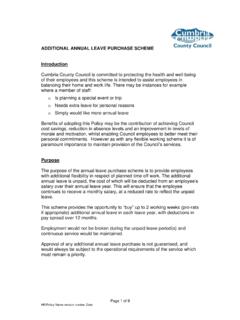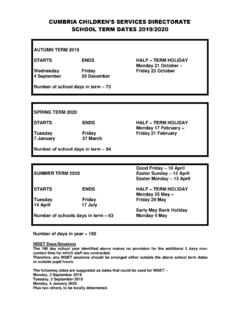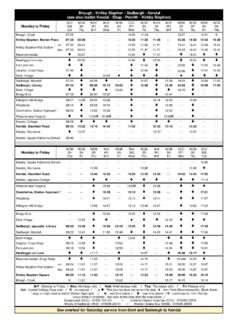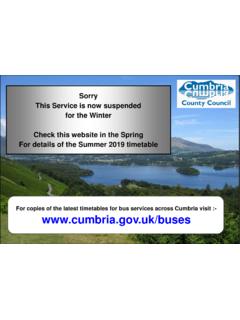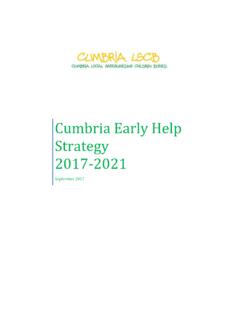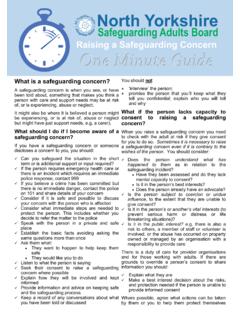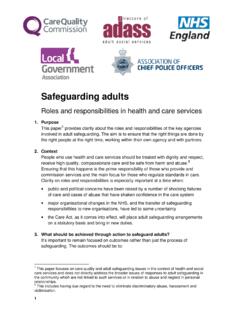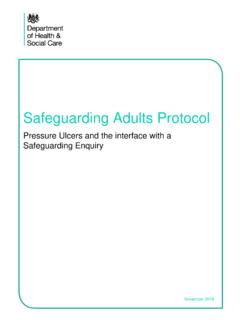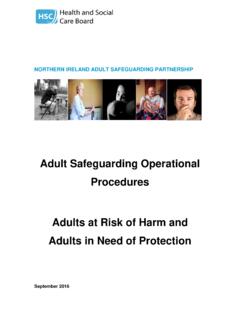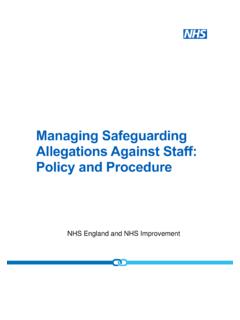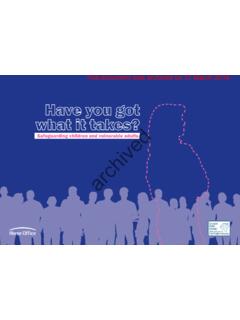Transcription of CSAB Safeguarding Adults Thresholds Tool and Guidance
1 Safeguarding Adults Threshold ToolFebruary @cumbriasab2 ContentsIntroduction 3 Care Act 2014 4 Principles 4 Guidance 5 Key Considerations 5 Making Safeguarding Personal (MSP) 6 Responding to concerns 6 Threshold Decision Making Guidance 6 Physical abuse 7 Sexual abuse 8 Psychological abuse 9 Financial abuse 10N e g l e c t 11 Organisation abuse 12 Discriminatory abuse
2 13 Modern Slavery 14 Domestic Abuse 15 Self-Neglect 16 Pressure Ulcers 17 Falls 18 Maladministration of Medication 19 Service user to service user 20 Neglect & Acts of Omission 213 Safeguarding Adults Thresholds Tool - February 2021 IntroductionThe concept of introducing a threshold Guidance to adult Safeguarding practice is a contentious issue, particularly after the introduction of the Care Act 2014; the Care Act gave rise to a shift from previous adult protection work to be a more inclusive response to Adults with care and support needs who may be at risk of abuse/neglect.
3 The Care Act and associated statutory Guidance was introduced to ensure an improved and more consistent approach to care and support nationally. Turning the focus onto the person rather than services . However, over the last few years, confusion has arisen within Cumbria around the decision of when to refer to the local authority under the Safeguarding Adults procedures or when another approach is the most appropriate. It is imperative that a consistent approach to Safeguarding Adults practice is developed. Introducing a Thresholds guide is one way to improve and develop guide seeks to support practitioners, partners and providers, working within the adult sector, to report and respond to concerns at the appropriate level and to have a consistency of approach across agencies. This Guidance is not a substitute for professional judgement, but should be used to assist decision making and to support professional judgement. The Guidance should be used to: Help determine a consistent approach to identifying what concerns may require a response under the Safeguarding process Support decision making when alternative processes should be Adults Thresholds Tool - February 2021 Care Act, 2014 Section 42 of the Care Act 2014 defines an adult at risk as an adult who: Has needs for care and support (whether or not the local authority is meeting any of those needs) and; Is experiencing, or at risk of, abuse or neglect.
4 And As a result of those needs is unable to protect themselves from either the risk of, or the experience of abuse or local authority retains the responsibility for overseeing a Safeguarding enquiry and ensuring that any investigation satisfies its duty under section 42 to decide what action (if any) is necessary to help and protect the adult, and to ensure that such action is taken when Care Act 2014 has introduced the requirement to record additional categories of abuse such as Female Genital Mutilation, Modern Slavery, Self-neglect, so called Honour Based Violence and Domestic Abuse. It should be noted that these categories may be seen within other categories of of the Care Act Statutory Guidance is clear that Safeguarding is not a substitute for: Providers responsibility to provide safe and high quality care and support Commissioners regularly assuring themselves of the safety and effectiveness of commissioned services The Care Quality Commission (CQC) ensuring that regulated providers comply with the fundamental standards of care or by taking enforcement action The core duties of the police to prevent and detect crime and protect life and property.
5 PrinciplesThis threshold Guidance is underpinned by the 6 principles of Safeguarding and the Mental Capacity Act 2005. Making Safeguarding Personal must also be applied in all decision making and must be used by all agencies working in adult provision:Empowerment - People being supported and encouraged to make their own decisions and informed - It is better to take action before harm occursProportionality - Proportionate and least intrusive response appropriate to the risk - Support and representation for those in greatest - Local solutions through services working with their communities. Communities have a part to play in preventing, detecting and reporting neglect and abuseAccountability - Accountability and transparency in delivering Adults Thresholds Tool - February 2021 GuidanceThreshold decision making can be complex, often an incident may consist of several types of abuse which must be factored into decision making. For example a medication error could be an indication of institutional, physical, psychological abuse or neglect.
6 However a medication error may be just an error, and may be a quality of care Adult Safeguarding Thresholds Guidance is a model that should be seen as a guide to managing risk for Safeguarding concerns, it should be used in conjunction with providers and practitioners own multi-agency procedures and has been produced to: Offer consistency Provide a framework that allows multi agency partners to manage risk Assist in differentiating between quality issues and Safeguarding riskIts intention is to help providers and practitioners identify the levels of support and the response required when a concern is suspected or an incident is recognised. It helps you consider the type and seriousness of abuse and the circumstances that a referral to Adult Social Care is must be proportionate and directed at preventing vulnerability and risk and promoting the wellbeing of Adults at risk of abuse. This Guidance has been agreed by the Cumbria Safeguarding Adults Board (CSAB) and will be used by all agencies, in the public, private and voluntary sectors that provide adult Considerations How long has the alleged abuse been occurring for What is the seriousness or impact of the suspected harm on the individual Is there a pattern of abuse Have there been previous concerns not just Safeguarding adult referrals, but other issues related to the adult, Anti-social behaviour, hate crime incidents and also in relation to the person alleged to be causing harm Has a previous plan to mitigate the concern not been successful has it lacked robustness or implementation Any other Adults at risk Is the situation monitored Are the incidents increasing in frequency and/ or severity Are there children present and if so consider making a Children s Social Care referral by contacting Cumbria SafeguardingPersonal (MSP)
7 Whether an incident is low risk or high risk, it is important to consider the views of the adult or the adult s advocate and record them. When considering the impact, always identify the individual s account of the depth and conviction of their feelings. What effect did it have on the individual? MSP means the actions of all staff working with the adult at risk should be person led and outcome to concernsAll incidents must be recorded and reported using the appropriate procedures but not all incidents will be Safeguarding IS IMPORTANT TO CONSIDER IN THE FIRST INSTANCE WHETHER SOMEONE IS IN IMMEDIATE DANGER - OR HAS BEEN THE SUBJECT OF A CRIME. CRIMINAL ACTS MUST BE REPORTED TO THE POLICE AND/OR EMERGENCY TREATMENT SHOULD BE SOUGHT WHERE NECESSARY. YOU SHOULD ALWAYS SEEK ADVICE FROM YOUR LINE MANAGER OR Safeguarding LEAD IF YOU HAVE A CONCERN AND IF IN DOUBT CONTACT THE COUNCIL SINGLE POINT OF ACCESST hreshold Decision Making GuidanceIn respect of Green record the incident and take action to respect of yellow record the incident, consult own agency Safeguarding lead/policies and procedures.
8 Take actions to reduce risk. Consult with Adult Social respect of Red in addition to the above, raise a Safeguarding Concern with Adult have been provided of possible actions that should be considered at every stage. These are offered as examples only and should not be considered exhaustive. It is important that following any incident a review should be undertaken and an action plan put in place to ensure lessons are learnt and the risk of the incident being repeated is reduced. It is also important to review all incidents in the context of those previously recorded as a series of similar incidents may meet the criteria for referral into Safeguarding . The CQC, as part of the inspection process, will require evidence of your decision making to confirm internal reviews, including subsequent actions, have taken place. 7 Safeguarding Adults Thresholds Tool - February 2021 Type of abuseNon-reportableRequires consultationReportablePHYSICAL The act of causing physical harm to someone elseFalls/medication/ pressure ulcers and service user on service user incidents - see separate riskNo impactMedium risk Some harm or risk of harmHigh riskSignificant harm or risk of harmLower level concern where threshold of further enquires under Safeguarding are unlikely to be met.
9 However, agencies should keep a written internal record of what happened and what action was taken, following your own internal there are a number of low level concerns consideration should be given as to whether the threshold is met for a Safeguarding enquiry due to increased riskIncidents at this level could be discussed with the local adult social care service. After the conversation, they may request you formally report the concern as a safeguardingIncidents at this level should be reported to your local adult social care service and directed to the Safeguarding team NB: You may need to contact the police/emergency : No harm/impact has occurred Isolated incident Physical contact but not with sufficient force to cause a mark or bruise, and adult is not distressed Appropriate moving and handling procedures not followed on one occasion not resulting in harm Error by staff causing little/no harm skin mark due to ill-fitting hoist Simply resolved Robust recording is in place Relevant and appropriate risk assessments/action plan in place Minor incident that meets the criteria for incident reporting accidents Incident not caused by a Person in a Position of TrustExamples.
10 Unexplained minor marking or lesions, minor cuts or grips marks found on a number of occasions or on a number of service users cared for by the same team/carer Repeated incidents/patterns of similar concerns Carer breakdown Inappropriate restraint that causes marks but no external medical treatment/ consultation required Risk can/cannot be managed appropriately with current professional oversight Accumulation of minor incidents Incident not caused by Person in a Position of TrustExamples: Unexplained, significant injuries. Assault Intended harm towards a service user Deliberately withholding food, drinks or aids to independence Physical assaults or actions that result in significant harm or where there is ongoing distress to the adult. Predictable and preventable incident between Adults where injuries have been sustained or emotional distressed caused Inappropriate restraint that requires medical treatment Incident caused by a Person in a Position of TrustActions/Outcomes to consider at every stageAdvice, information, review of care plans, risk management planning, staff training.

